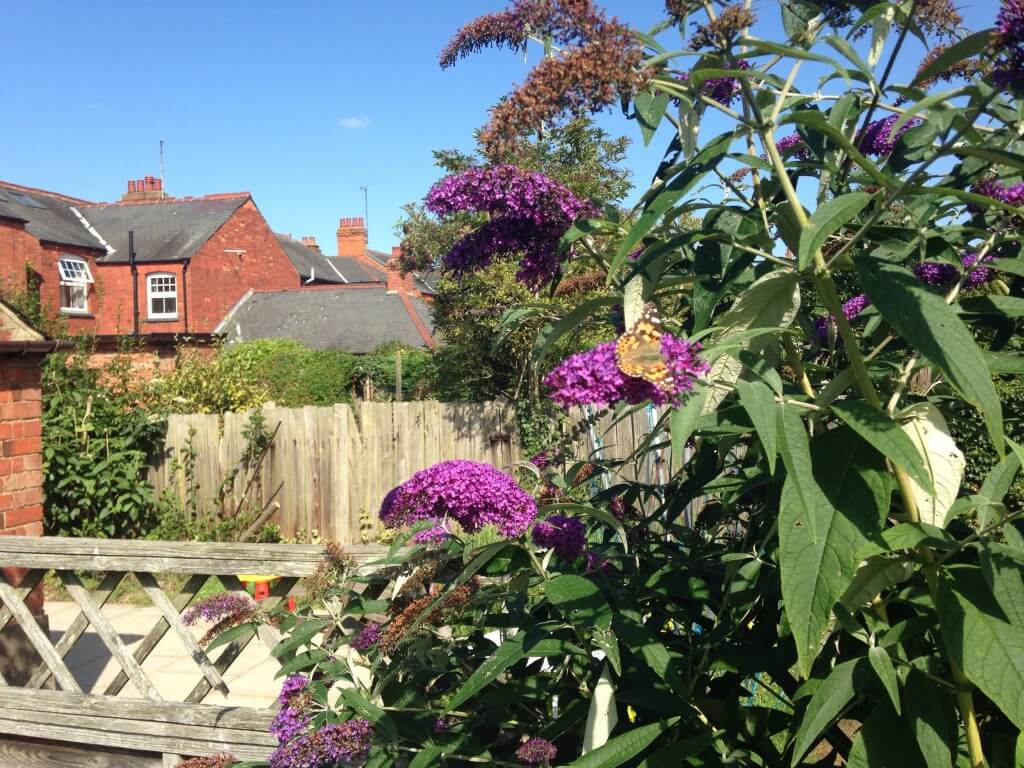My late-flowering buddleia is a delight – in a good year. It’s too early to tell if this year is a good year.
It really comes into its own in an indian summer when there are few other flowering plants around and it acts like a butterfly magnet. Yesterday afternoon there was this Painted Lady (my second of the year, only) up to four Red Admirals and up to two Large Whites on it.
I’ll be keeping an eye on it over the next couple of weeks to see how it shapes up.
And remember my rule of butterflies on buddleias – there are almost always more there than you originally thought.
[registration_form]
I do like a good buddlejar. Few pests and even fewer diseases. Apart from the evil figwort weevil, destroyer of favourites, that prefers B globosum and B x Weyeriana to B davidii. The control method suggested is to pick them off. Yeah, right …
Butterflies do indeed love them and so do a lot of others – bumblebees especially and hummingbird hawk moths, which for some reason are unusually numerous this year at Cobb Towers. For sheer pollinator popularity flowering ivy has buddlejar beat, though but. Wandering around with my brushcutter idling, looking for more stuff to tidy, I was instructed by Dearly Beloved not to touch that ivy because all them bees love it. In fact there wasn’t a bee on it. When Mrs C returned from Specsavers she informed me that them bees had turned into hornets.
Worth popping out into the garden after dark with a torch to see what is visiting the buddliea then. Moths love it too!
Jonathan – really? I didn’t realise that.
I found out buddleias were great for moths as a boy. There can be as many or more moths at night, than butterflies during the day. Michaelmas Daisies are also good for late pollinators, including butterflies. Ivy flowers to. Ideally they want to be situated in a sheltered sun trap i.e. as shielded from the wind as possible, but facing the sun when it gets lower. If you look out for such spots with later flowers, you will find lots feeding insects and butterflies surprisingly late in the year.
I’ve seen a sycamore absolutely covered in ivy, catching the sun that when you looked up you would see nothing but flies, hover flies and bees going to the flowers. This was mid November in Scotland.
I’ve seen the same in Lancashire Les. I watched a patch on a wall for a couple of years until someone decided to cut it off. I realised there was a lot more to it than Ivy simply having late flowers. Ivy in a sheltered spot supports a host of late pollinators for a variety of reasons. The Ivy itself traps heat on warm days, and it provides a little micro-climate sheltered from cooling winds. This allows the flower feeding insects to shelter in it. What’s more, these mainly flying insects don’t have to fly to the flowers, which involves warming up to flying temperature. The insects can directly walk along the stems, and feed on the flowers without having to fly to them. This allows the insects to feed on flowers, when it would be otherwise too cold for them.
Flying insects tend to mainly feed when it is sunny, because they need to warm up their bodies to flying temperature and fly to find flowers. This warming up uses up a lot of energy, and the insect can use more energy that it can regain by feeding. It is difficult to find enough food when cooler. But by using radiant heat from the sun to warm up to flying temperature, they save a lot of energy, and can find far more flowers to feed on, hence they can get more energy back in return.
Jonathan – really? I didn’t realise that.
On our garden Buddleia we had: Red Admiral 6, Comma 1 and Small White 1. What drew my attention was a violently flapping RA which eventually flew away, leaving a Hornet. So that is why some butterflies look a bit ragged. The hornet continued patrolling the buddleia, with little success. So no need for any predator control. Oh and hornets fly at night too, they are often attracted to the light of the office window.
Mrs C finds their yellow faces at the window after dark quite intimidating. If one gets into the house the dog goes bananas until I trap the buzzer under a glass and remove it to the freezer so that it won’t release any fear-o-moans
I have 5 large buddliea bushes, I have noticed a sharp decline in Butterfly activity in the last 3 years. If you want to prolong flowering; cut the brown flower heads off and you should get a second flourish of late flowers. In spring cut Buddlieas back hard to encourage thick and luscious growth.
One of my first childhood wildlife memories was watching butterflies on our “butterfly bush” at home in the mid 1970s. Lovely plant with a lovely smell, particularly at dusk. The smell brings back some great childhood memories. It was also one of my late father’s favourite plants which makes it extra special to me.
All this despite me killing one in my first garden as a 20 something single bloke! It was a present from my Mum who said they were unkillable, sadly she was wrong! We have 2 in our garden now, thankfully my wife is a keen gardener and looks after them!